The three Evertsen class were the first Dutch Netherland’s Navy modern coastal battleships, built after a long line of monitors. Built in 1893-96, they played their role as deterrent before WWI and started to be decommissioned in 1913, 1914, and 1920 for HRMS Kortenaer, as a schoolship.
Initial Incentive
In 1890, the Royal Dutch Netherlands Navy was resolutely a coastal, green water navy, and albeit powerful in the late 1880s still, most of its 1860-70s monitors and turreted rams had been decommissioned or were about to be retired. Her most impressive ship so far was the 5300t 1874 Koning Der Nederlanden Draak (1877), and matador (1878). All were now approaching the limit of their capabilities and were no longer on par with the latest technological developments in order navies. A naval plan was drafted to modernize the navy with new orders in the 1890s, but this was long in coming. The Dutch Empire had been dwindling down, with only the Dutch West (Carribean) and East (Java-Indonesia) Indies still bringing up revenues for a rather small country.
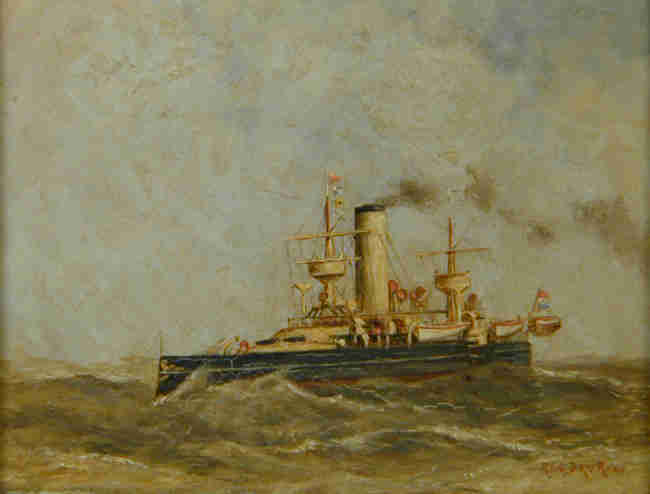
Painting of Evertsen by Richardus Philippus Arnoldus van Rees
This financed only FY1891 a small (2440t) monitor. Albeit an improvement over the antiquated Draak and Matador, HNLMS Reinier Claeszen was powered by an HT steam engine only capable of 2,315 hp (4,700 in order sources), enough for 12.5 knots. She had a ram bow (and was designed as such) and was armed with a single turreted 8.2 inches/35 Krupp gun forward, a rear mounted 6.7 in/35 gun aft, four 4-pdr guns and torpedo tube. She proved a bad steamer, unseaworthy, and unwieldy to the point she ran aground many times during her short career.
After her only “combat” action of repressing the strikes of Amsterdam and Rotterdam, her modernization on April 22, 1913 was stopped and she was decommissioned instead in April 1914, used as floating oil depot in WWI.
In between, new needs arose, with the rapid extension of the Japanese and Chinese Navies. The protection of the colonies in the Dutch East Indies became a topic of interest and battle fleets expanded. In 1887, local authorities already sihnalled two German built ironclads being accepted into service and they were considered much superior to local Dutch defence. There was an important Chinese merchant community in the colonies, and Chinese Imperial ambitions led to rethink about local defences. In April 1892, a plan to bolster and modernize the colonial fleet were formulated by a committee of three officers, J.H. Kromhout, F.J. Haver Droeze and G. Kruys.
Naval expert, rear admiral and chief of the naval staff Gerhardus Kruys milited for the procurement of a full squadron of modern armoured ships. These recommendations were adopted by the government, and this led to a contract to be awarded for the first class of these, Hr.Ms. Evertsen, Hr.Ms. Kortenaer and Hr.Ms. Piet Hein. The Navy managed to obtain the funding of a full class of three proper coastal defence battleships, seaworthy enough, and not just ram-monitors. They were supposed to be much faster, better armed and better protected.
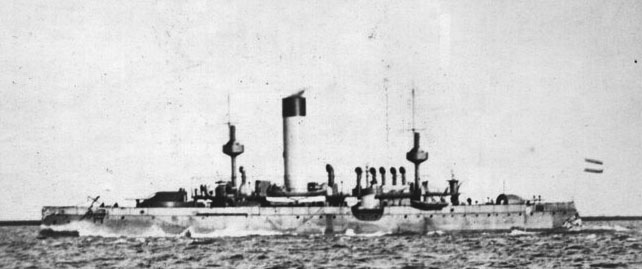
Thus, three 3,500 tonnes coast defense ships were ordered in 1892 at Fijenoord, Amsterdam and de Schelde Yards, all launched in 1894 and completed in 1895-96. They were the first with a complete waterline armoured belt. They were better armed also, with no less than three (one twin and one single) 210 mm/35 Krupp guns, two single 150mm/35 Krupp guns, six single Vickers 75mm guns and three 450 mm torpedo tubes. Their armor reached 150mm thick for the belt and 240mm for the gun turrets faces. However only Kortenaer was still operational when WWI broke out. Evertsen was discarded in 1913 and Piet Hein in 1914. The next Koningin Regentes class (1900) improved on the design and were this time capable overseas deployments.
In fact, only Piet Hein was sent to the East Indies from 1899 to 1901, as approval only mattered if their could be used for the Netherlands and Caribbean defenses.
The last line of defence
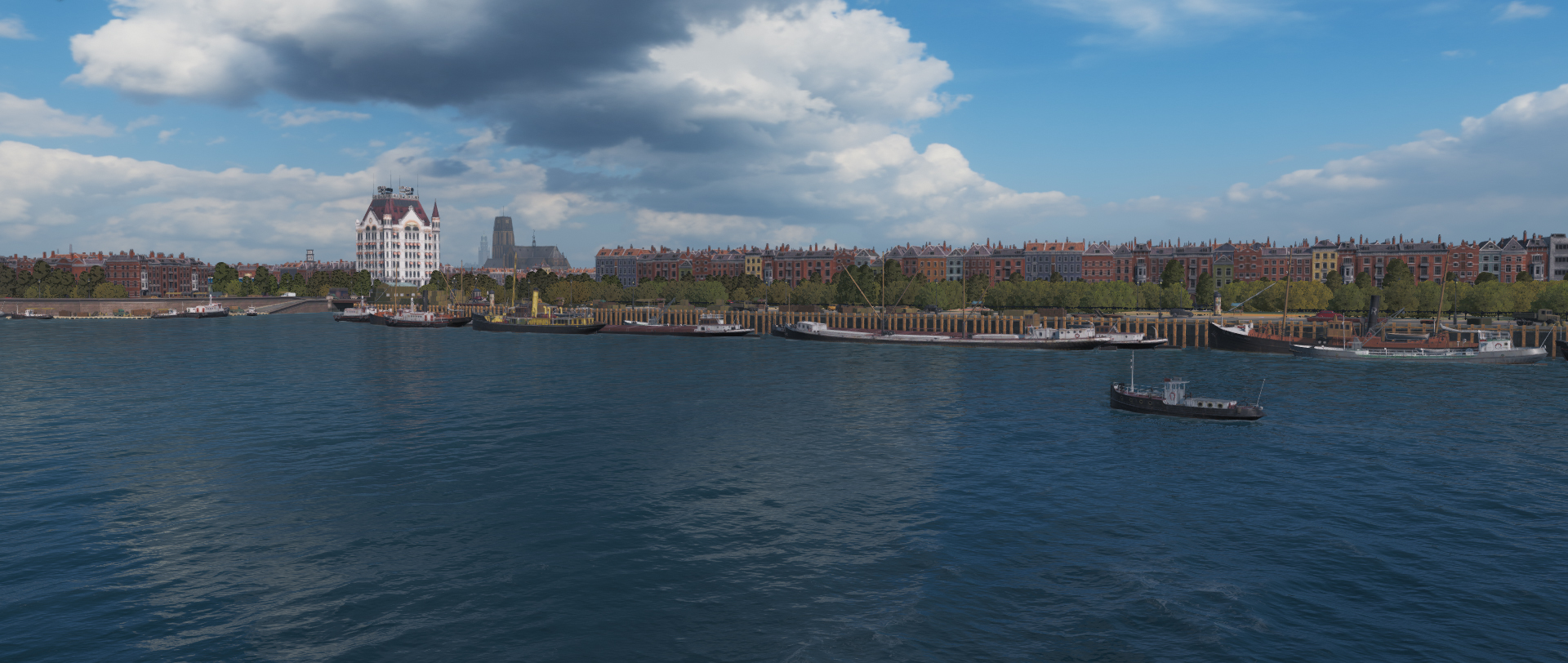
Amsterdam in the early 1900s (WoW)
Like most northern countries, the late 1890s saw some trust given to a less costly but still effective class for deterrence: The coastal battleship. Many were produced and used by the Navies of Denmark, Norway, Sweden. Even the recent Imperial German Navy had those before any true scale battleships, while the USN still relied on their monitors and the French favored them as part as their Jeune Ecole credo.
The Netherlands were no different. Since the 1850s they saw the rise of armor and departed from traditional wooden vessels, screw frigates in service. In 1863, the Dutch Navy had its first broadside ironclad (De Ruyter), converted from an older 74 guns vessels. In 1866 was launched its first turret ship (Prinz Hendrik der Nederlander), on 1868-70 two Buffel ironclad rams, and two Scjorpioen turret rams, plus eleven monitors built in 1868-71. Two more were built in the 1870s, Draak and Matador, but in 1891 was launched HRMS Reinier Claeszen, largest sea going monitor of the Dutch Navy so far.

Evertsen in the Noordzeekanaal ca1900
Many thought these Monitors were unable to defend the colonies in case of war and wanted a larger, more rounded armored vessel, not a mere coastal monitor. This was the genesis, in 1891, of the Evertsen class. They would be the first modern true coastal battleships of the Ductch Navy, still heavily armed, but more balanced with secondary weapons and torpedoes, a larger draft and seakeeping qualities as well as better speed and armor. This was an ambitious programme, concluded with the launching of three vessels at Fijenoord, Amsterdam and Schelde, launched in 1894 and completed in 1896.
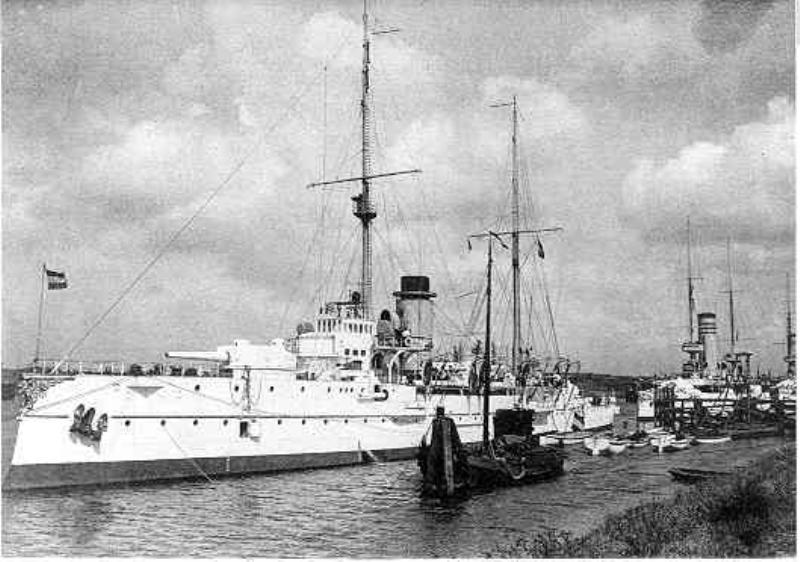
HRMS Jacob Van Heemskerck, with the three Evertsen class behind, berthed in a canal.
The formula was so successful they will be followed by the three larger Konigin Regentes in 1900-1902, and the very large HRMS Tromp in 1904 and Jacob Van Heemskerck in 1906. These eight vessels made the bulk of the Navy deterrence when WWI broke out, while projects were made for proper dreadnoughts to defend the East Indies. But that’s for another day.
Design of the Evertsen class
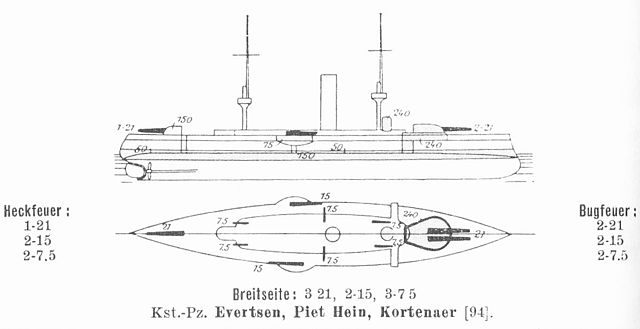
To create these pantserschepen, the admiralty though of large guns that can deter an opponent, but having little experience in that matter, the Krupp 21 cm L/35 was adopted right away. Discussion then went on the best possible location and it was agreed for stability reasons not to go with the classic ironclad configuration of the time, with two paired barbettes fore and aft, but rather that forward fire, during a defensive sortie, was the most potent and so, the configuration in a twin turret forward and single aft was adopted.
Another point of debate was the size of the hull. It was calculated from the size of the forward barbette, which was larger. The twin barbette was farther from the ram bow than the stern chase gun, and the superstructure was built in between.
Hull and general design
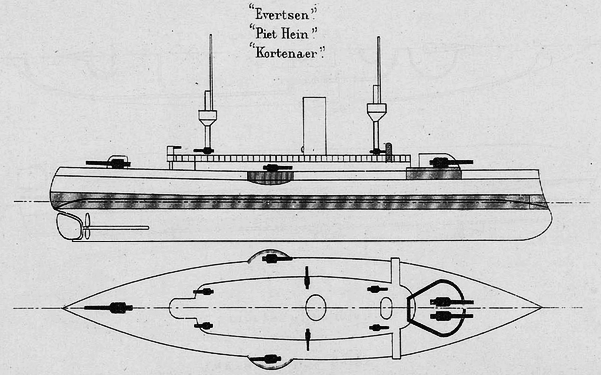
Depicted on Brasseys naval annual
Their hull was 86.2 metres (282 ft 10 in) long, for 14.33 metres (47 ft) in beam and 5.23 metres (17 ft 2 in) of draught, resulting in a contracted displacement of 3,464 ton.
There two military masts had the same height, in two parts. The lower, thicker base supported military tops with a rounded triangular shape. The two forward corners supported Hotchkiss QF guns. The main bridge had an hemispheric face, metal-covered for splinter protection. There was an open platform aft of the roof mounting a forward main projector. The second one was on raised platform aft, ending the upper deck.
The forward and only conning tower was located just begind the main bridge, with the formast behind. A small radio room, with wooden paneling was installed forward and close to the main funnel, with wreless telegraphy masts. The aft part of the battery roof or upper deck was dotted with seven tall air intakes. The deck superstructures were not continuous but comprised a main block starting around the funnel, ending aft of it and the quartedeck structure aft, before the mainmast. The bridge and CT was supported by a large cyclindrical, armored base.
These armored battleships carried boats on davits, eight in all along the hull, at battery deck level. Steam pinnaces/picket boats were located aft of the secondary sponson guns, setting below its lower fire angle. In case of heavy seas however, these boats would have been toasted on the flanks. The buyancy reserve was considerable but the hull sat very low, at just a deck level above the waterline. Both the prow and stern were lavishly decorated by fake gold motives typical of the late XIXth century.
Powerplant
The ships were equipped with 2 shaft reciprocating engines, which were rated at 4,700 ihp (3,500 kW) and produced a top speed of 16 knots (30 km/h). The six cylindrical boilers were truncated into a single very large, tall funnel ensuring good draft. Combined with relatively short masts, this was the greatest recoignition point for these vessels.
Armour protection layout
The ships of the class were protected by Krupp (not cemented) armor. It was wella adjusted for their own caliber and able to resist armoured cruisers armed the same.
-Belt: 150mm (6 in) amidships, 100mm (4 in) ends 100% length
-Belt sloped to armored deck: 55mm (2.2 in), turtleback on ends.
-Fwd barbette 240mm (10 in) thick walls
-Beam barbettes secondary guns 75mm (3 in) armour
-Aft main barbette 150 mm (6 in)
Armament
The main armament of the ships where three 8.2 in (21 cm) guns in a double and single turret. Secondary armament included two single 15 cm (5.9 in) guns and six single 7.5 cm (3.0 in) guns. The first were 209mm/32 Krupp No.2 guns forward, a single 209 mm/35 Krupp No.2 aft in barbette, two single 149mm/35 Krupp No.1 guns on either beam’s sponsons and six single 75mm/37 Krupp (3 in) No.1 Krupp guns, completed at the time by eight single 37mm/20 Hotchkiss QF repeating guns and three 450 torpedo tubes, two in the beam and one aft in chase.
The design of the lain barbettes cover was also quite different. The forward one was an integral cover, hemispheric cupola ending with a rear director station. The aft one was simple cover which left the aft section wide open for servants.
8.2 in/32 Krupp (21 cm)
In 1886, Krupp designed the 21 cm L/35 (8.2 in) gun for the domestic needs and soon export customers, in 1890. The No. 1 and No. 2 existed and the latter were adopted by the Netherlands for numerous ships: In addition to the Evertsen-class, Hydra-class, Koningin Wilhelmina der Nederlanden, Reiner Claeszen and Sumatra. The models differed by their weight, rifling, propellant charges and muzzle velocities.
It fired a 140 kg (310 lb), 209.3 mm (8.24 in) 35 caliber shell, capable of 580 m/s (1,900 ft/s) with a 54 kg (119 lb) propellant charge. Range and rate of fire figures are unknown (so far).
2x 15 cm (5.9 in)
Secondary armament comprised two single Krupp 15 cm guns on sponsons bulging amidship, under simple masks. The 15 cm Schnelladekanone Länge 35 was widely exported, and designed from 1880. It used a separate loading cased charge and projectile, with a shell weight of 45.6 kg (101 lb), 149.1 mm (5.87 in) 35 in exact caliber. The gun had a horizontal sliding breech block elevating -7° to +20°. It was capable of 4-5 rpm rate if fire at 650 m/s (2,100 ft/s), up to 10 km range (6.2 mi) at +19°. It was also shared by the Cruiser Sumatra.
6x 7.5 cm (3.0 in)
The Krupp 75mm gun M.1880 was declined as field and shipborn models. Figures as those of the feldkanone C/80. It fired a 4.3 kg shell with a 100 g charge, at 6,100 m. muzzle velocoity was 460 m/s but it was slow-firing. They were all installed under masks on the upper deck (superstructure), fore and aft and amidship.
8× 1-pounder QF
The classic Hotchkiss semi-auto 37 mm “machine gun”. Similar to the Gatling system, this was a five-barrel gun, which needed frequent reloading. The rate of fire was essential to deal with closing in torpedo boats escaping the 8cm fire. Four were installed on the fighting tops, and the others along the upper deck.
3× 45 cm (18 in) TTs
The three 45 cm (18 in) torpedo tubes were fixed, two firing in the broadside, one aft. Model unknown, likely the Whitehead Model. I have no info of 1880s German torpedoes.

Profile
⚙ Evertsen as built, specifications |
|
| Dimensions | 86.2m x 14.3m x 5.23m (282 ft 10 in x 47 ft x 17 ft 2 in) |
| Displacement | 3,464 tons standard, 4,800 tons Fully Loaded |
| Propulsion | 2 VTE, 6 cyl. boilers, 4,700 ihp. |
| Speed | 16 knots (30 km/h) |
| Range | 2800 nm @ 9 knots based on 289 t of coal. |
| Armament | 1×2, 1×1 21cm/35 Krupp No.2, 2x 15cm/35 Krupp No.1, 6x 7,5cm/37 Krupp No.1, 8x 3,7cm/20 Hotchkiss, 3x 45cm TT |
| Protection | KC steel belt 100-150, deck 55, barbette, CT 240mm |
| Crew | 263 officers and ratings |
Read More
Books
Staatsbegrooting voor het dienstjaar 1897
Rotterdams Nieuwsblad, 19 Juli 1911
Het Nieuws van de Dag: kleine courant, 1 Juni 1912
Gardiner, Robert; Chesneau, Roger; Kolesnik, Eugene M., eds. (1979). Conway’s All the World’s Fighting Ships, 1860-1905. p.374
Jane, Fred T. (1900). All The World’s Fighting Ships. London: Sampson Low, Marston & Co.
Jane, Fred T., ed. (1970). Jane’s Fighting Ships 1905-6. New York.
Raven, G.J.A., ed. (1988). De kroon op het anker: 175 jaar Koninklijke Marine. Amsterdam: De Bataafsche Leeuw.
Links
Staatsbegrooting voor het dienstjaar 1897
navypedia.org
battleships-cruisers.co.uk
navalhistory.flixco.info
nl.wikipedia.org/ Hr.Ms._Evertsen_(1896)
en.wikipedia.org/wiki/Evertsen-class
nl.wikipedia.org/wiki/Evertsenklasse
commons.wikimedia.org/wiki/Category:Evertsen_class
Marineblad, Volume 11, 1897
Jaarverslag, Volumes 29 à 32. Nederlandsche Vereeniging van Werktuig- en Scheepsbouwkundigen 1897
on pure.knaw.nl/ws/
Model Kits
None discovered so far.
The Evertsen in service 1896-1920
 HRMS Evertsen
HRMS Evertsen
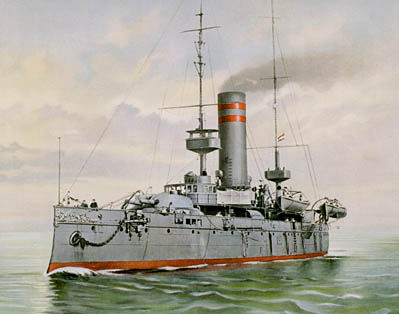
Painting of the Evertsen in 1911-14 during her north sea sorties, in grey livery.
The lead ship of her class was laid down in 1893 at the Koninklijke Maatschappij, De Schelde Yard, in Flushing. She was launched on 29 September 1894 and commissioned on 1 February 1896. On 4 February 1896 she and Kortenaer left home waters for exercizes in the Mediterranean. On 11 May 1896 the harbor strikes in Rotterdam saw her like her sister, patrolling the Meuse river, and later she was relieved by Evertsen, Piet Hein and the police schooner Argus. The strikes eventually ended on 21 May.
On 5 May 1898, she left Den Helder for Lisbon, for the celebration of the discovery of the seaway to India by Vasco da Gama 400 years ago. Incidentally, she was there to see a possible deployment of the home armada (Spanish Navy) possibly called for reinforcement of Cuba. HDMS Evertsen hosted the Portuguese king Carlos I and his wife during a state visit. Northing muhch happened in her career the following years. She alternated betwene summer exercizes and long period of rest and maintenance, or inactivity. In 1911-1913 Captain lieutenant Jean Jacques Rambonnet took command. She made several the North Sea sorties and cruises for training, meeting an saluting ships of the RN and Kaiserliches Marine along the way. She was was finally decommissioned in 1913 and thus, never saw the great war.
 HRMS Kortenaer
HRMS Kortenaer
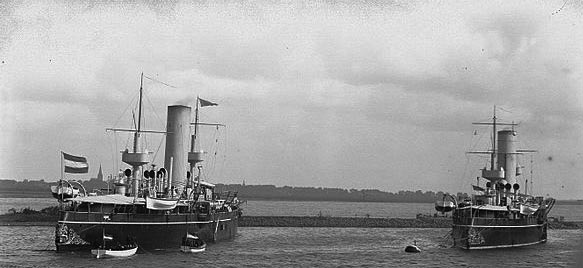
Kortenaer and Piet Hein in the 1890s
HDMS Kortenaer was laid down in 1893 at Rijkswerf Yard, Amsterdam. She was launched on 27 October 1894 and commissioned on 17 December 1895. On 4 February 1896 with HDMS Evertsen she left home waters for the Mediterranean Sea and start a round of sailing and gunnery practice. On 11 May 1896, when home, she was struck by the harbor strikes in Rotterdam. The government decided a ban on assembly and after two days she patrolled the Meuse River, but some in the crew still caused unreste. She was relieved by Evertsen and Piet Hein, boarded by the police schooner Argus. 300 grenadiers put an end to the strikes on 21 may 1896.
Nothing much happened until 1900 and up to 30 May 1913 when Kortenaer sailed to Constantinople, relieving the cruiser HDMS Gelderland sent on 11 November 1912 due to high political tension and to protech Dutch and international residents and assets. On 12 April 1914 she was based in the East Indies, Curaçao, when ordered to sail to the Mexican coast. There, unrest caused action, so she was there to protect the national petrol company La Corona, in Tampico. During WWI she stayed close to shore, patrolling home waters without incident until decommissioned in 1920.
 HRMS Piet Hein
HRMS Piet Hein
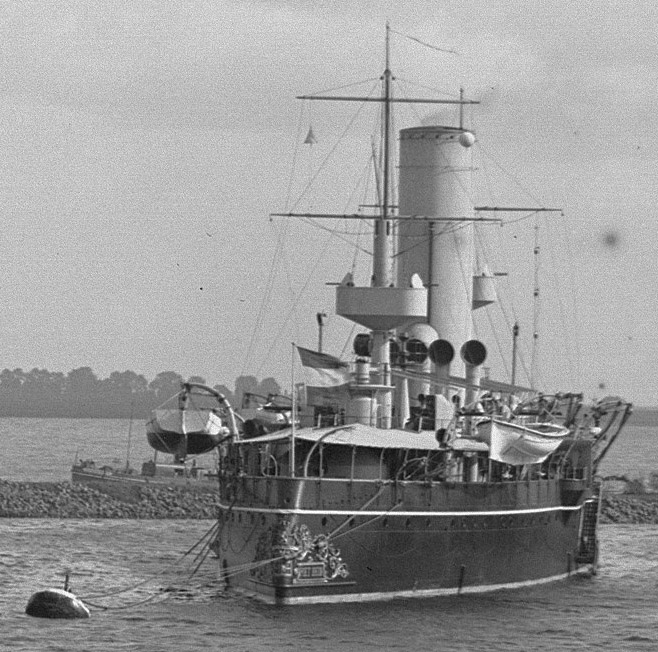
HNLMS Piet Hein in 1894 at Afgesloten
HRMS Piet Hein was laid down in 1893 at the Nederlandsche Stoomboot Maatschappij, Rotterdam. She was launched on 16 August 1894 and commissioned on 3 January 1896. On 11 May 1896 she like all other three, took part in quelling harbor strikes in Rotterdam, patrolling the Meuse and helping grenadiers deployed during the strikes, over on 21 may. In between 1900 not much happened, with the same yearly routine of exercizes as her sisters. This included gunnery exercizes.
In 1900 she departed for a long trip with the cruiser Holland and the coastal battleship Koningin Wilhelmina der Nederlanden, to Shanghai via Suez, to save guard European citizens and Dutch interests during the Boxer Rebellion. Back from there in February 1901 she was stationed to guard Soerabaja in the Dutch East Indies, separated from her sister ships until the end of her service, as she was decommissioned in 1914, likely before August, and so never saw either WWI. She was replaced on station in April by her sister HRMS Kortenaer, the only one which saw service in WWI.
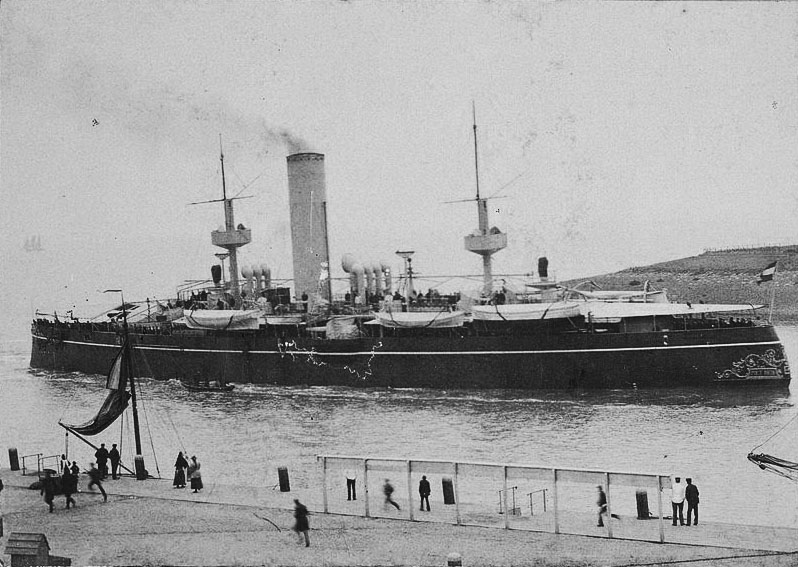
Piet Hein in Van Den Helder, date unknown
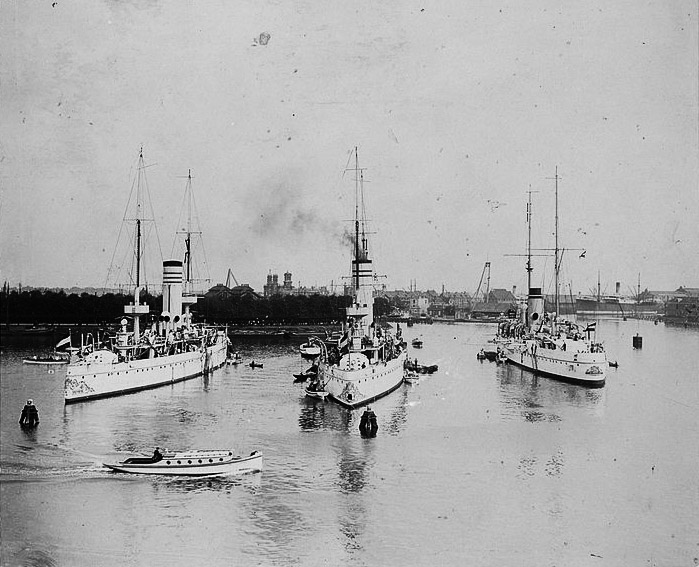
All the class abchored in Amsterdam
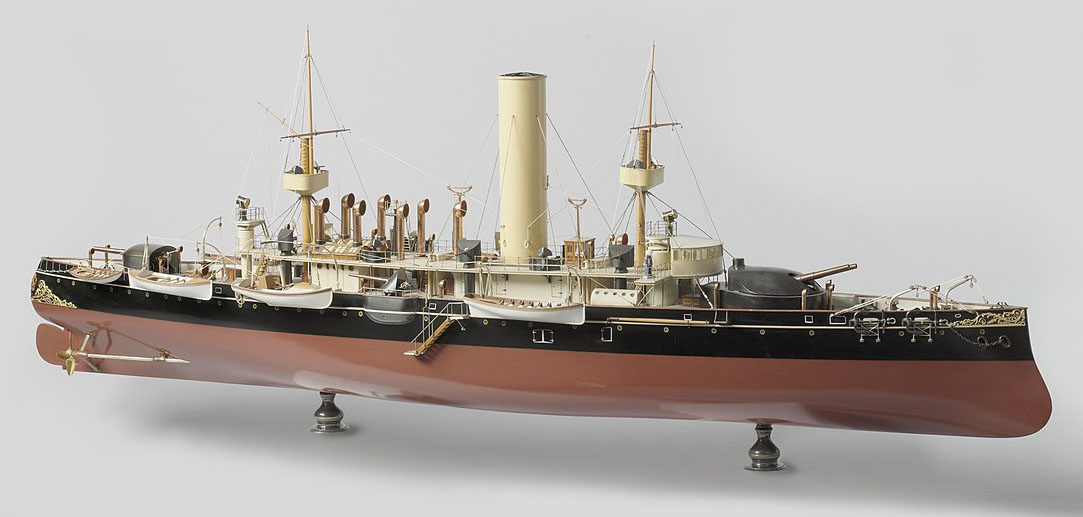
A model of the Vertsen class, as built
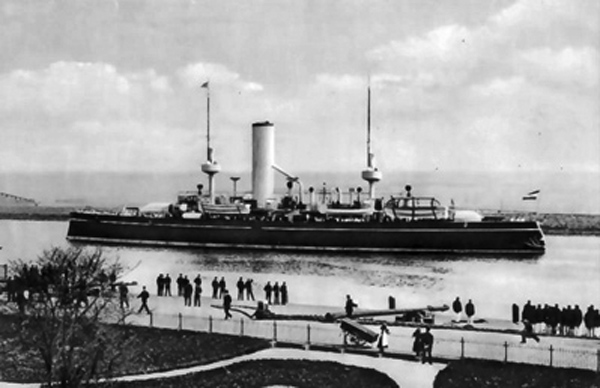
Hr. Ms Evertsen in harbor


 Latest Facebook Entry -
Latest Facebook Entry -  X(Tweeter) Naval Encyclopedia's deck archive
X(Tweeter) Naval Encyclopedia's deck archive Instagram (@navalencyc)
Instagram (@navalencyc)





 French Navy
French Navy Royal Navy
Royal Navy Russian Navy
Russian Navy Armada Espanola
Armada Espanola Austrian Navy
Austrian Navy K.u.K. Kriegsmarine
K.u.K. Kriegsmarine Dansk Marine
Dansk Marine Nautiko Hellenon
Nautiko Hellenon Koninklije Marine 1870
Koninklije Marine 1870 Marinha do Brasil
Marinha do Brasil Osmanlı Donanması
Osmanlı Donanması Marina Do Peru
Marina Do Peru Marinha do Portugal
Marinha do Portugal Regia Marina 1870
Regia Marina 1870 Nihhon Kaigun 1870
Nihhon Kaigun 1870 Preußische Marine 1870
Preußische Marine 1870 Russkiy Flot 1870
Russkiy Flot 1870 Svenska marinen
Svenska marinen Søværnet
Søværnet Union Navy
Union Navy Confederate Navy
Confederate Navy Armada de Argentina
Armada de Argentina Imperial Chinese Navy
Imperial Chinese Navy Marinha do Portugal
Marinha do Portugal Mexico
Mexico Kaiserliche Marine
Kaiserliche Marine 1898 US Navy
1898 US Navy Sovietskiy Flot
Sovietskiy Flot Royal Canadian Navy
Royal Canadian Navy Royal Australian Navy
Royal Australian Navy RNZN Fleet
RNZN Fleet Chinese Navy 1937
Chinese Navy 1937 Kriegsmarine
Kriegsmarine Chilean Navy
Chilean Navy Danish Navy
Danish Navy Finnish Navy
Finnish Navy Hellenic Navy
Hellenic Navy Polish Navy
Polish Navy Romanian Navy
Romanian Navy Turkish Navy
Turkish Navy Royal Yugoslav Navy
Royal Yugoslav Navy Royal Thai Navy
Royal Thai Navy Minor Navies
Minor Navies Albania
Albania Austria
Austria Belgium
Belgium Columbia
Columbia Costa Rica
Costa Rica Cuba
Cuba Czechoslovakia
Czechoslovakia Dominican Republic
Dominican Republic Haiti
Haiti Hungary
Hungary Honduras
Honduras Estonia
Estonia Iceland
Iceland Eire
Eire Equador
Equador Iran
Iran Iraq
Iraq Latvia
Latvia Liberia
Liberia Lithuania
Lithuania Mandchukuo
Mandchukuo Morocco
Morocco Nicaragua
Nicaragua Persia
Persia San Salvador
San Salvador Sarawak
Sarawak Uruguay
Uruguay Venezuela
Venezuela Zanzibar
Zanzibar Warsaw Pact Navies
Warsaw Pact Navies Bulgaria
Bulgaria Hungary
Hungary

 Bundesmarine
Bundesmarine Dutch Navy
Dutch Navy Hellenic Navy
Hellenic Navy Marina Militare
Marina Militare Yugoslav Navy
Yugoslav Navy Chinese Navy
Chinese Navy Indian Navy
Indian Navy Indonesian Navy
Indonesian Navy JMSDF
JMSDF North Korean Navy
North Korean Navy Pakistani Navy
Pakistani Navy Philippines Navy
Philippines Navy ROKN
ROKN Rep. of Singapore Navy
Rep. of Singapore Navy Taiwanese Navy
Taiwanese Navy IDF Navy
IDF Navy Saudi Navy
Saudi Navy Royal New Zealand Navy
Royal New Zealand Navy Egyptian Navy
Egyptian Navy South African Navy
South African Navy






























 Ukrainian Navy
Ukrainian Navy dbodesign
dbodesign